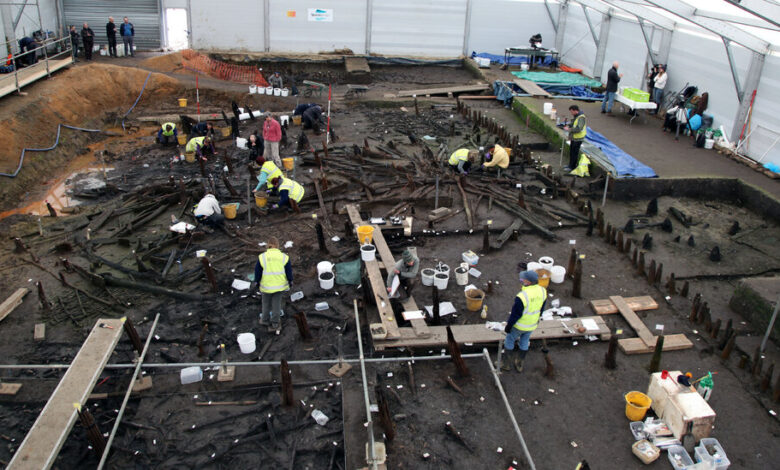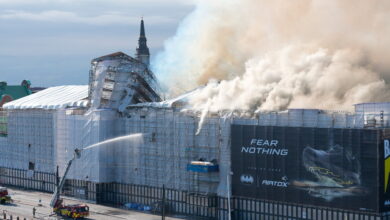This Was Village Life in Britain 3,000 Years In the past

[ad_1]
Three millenniums in the past, a small, affluent farming neighborhood briefly flourished within the freshwater marshes of jap England. The inhabitants lived in a clutch of thatched roundhouses constructed on picket stilts above a channel of the River Nene, which empties into the North Sea. They wore garments of superb flax linen, with pleats and tasseled hems; bartered for glass and amber beads imported from locations as far-flung as present-day Iran; drank from delicate clay poppyhead cups; dined on leg of boar and honey-glazed venison, and fed desk scraps to their canine.
Inside a yr of its building, this prehistoric idyll met a dramatic finish. A catastrophic fireplace tore by the compound; the buildings collapsed and the villagers fled, abandoning their clothes, instruments and weapons. The whole lot, together with the porridge left in cooking pots, crashed by the burning wicker flooring into the thick, sticky reed beds beneath and stayed there. Ultimately, the objects sank, hidden and entombed, in additional than six ft of oozing peat and silt. The river steadily moved course away from the encampment, however the particles remained intact for almost 3,000 years, preserving a file of day by day life on the finish of Britains’s Bronze Age, from 2500 B.C. to 800 B.C.
That frozen second in time is the topic of two monographs printed Tuesday by Cambridge College. Primarily based on a 10-month excavation of what’s now often known as Should Farm Quarry, a submerged and beautifully preserved settlement within the shadow of a potato-chip manufacturing unit 75 miles north of London, the research are as detailed as a forensic investigation report of against the law scene. One paper, a website synthesis, runs to 323 pages; the opposite, for specialists, is sort of 1,000 pages longer.
“This didn’t really feel like archaeology,” stated Mark Knight, the undertaking director and one of many paper’s authors. “At occasions, excavating the positioning felt barely impolite and intrusive, as if we had turned up after a tragedy, picked by somebody’s possessions and received a glimpse of what they did someday in 850 B.C.”
Proof for all times in Britain’s Bronze Age has historically come from fortified and spiritual websites which are typically discovered on excessive, dry landscapes. A lot of the clues come as pottery, flint instruments and bones. “Usually we’ve got to work with small bits and items and barely seen stays of homes, and skim between the strains,” stated Harry Fokkens, an archaeologist at Leiden College. Convincing anybody that such locations have been as soon as thriving settlements takes somewhat creativeness.
Paul Pettitt, a Paleolithic archaeologist at Durham College who was not concerned with the brand new research, stated the monograph — a case research of remarkable preservation mixed with extremely expert excavation — present a reminder that domesticity in that interval was “colourful, wealthy, diversified and never solely about metallic weapons, as the general public’s love of metallic detecting would recommend.”
Bogged Down
Francis Pryor, a British archaeologist finest recognized for his 1982 discovery of Flag Fen, a Bronze Age website one mile from Should Farm, added: “The Should Farm report is reworking our understanding of British society within the millennium earlier than the Roman Conquest, 2,000 years in the past. Removed from being primitive, Bronze Age communities lived in concord with their neighbors, whereas having fun with life in heat, dry homes with wonderful meals.”
Till a decade in the past, the so-called Pompeii of the Fen lay buried in a clay brick quarry, The unique hamlet is believed to have been twice as large — mining within the twentieth century obliterated half the archaeological website — and will have housed a number of dozen folks in household items.
What remained have been 4 substantial roundhouses and a small, sq. entranceway construction erected on a picket platform and surrounded by a six-foot-high palisade of sharpened ash posts, a barrier little question designed for protection. The inexperienced timber, recent wooden chips and the absence of restore, rebuilding or insect harm steered that the advanced was comparatively new on the time of the blaze.
An evaluation of the outermost progress rings of the scorched hardwood pointed to late autumn or early winter as the beginning date, whereas the skeletons of three- to six-month-old lambs and the charred larvae of an area species of flea beetle implied that the settlement was destroyed in summer season or early autumn.
By piecing collectively the fabric tradition of those historical Britons, the research reveals how the homes have been constructed and the family items inside, what the residents ate and the way their garments have been made.
Amongst different issues, the archaeologists unearthed 180 textiles and fiber objects (yarns, material, knotted nets), 160 picket artifacts (bobbins, benches, hafts for metallic instruments and wheels), 120 pottery vessels (bowls, jars, jugs) and 90 items of metalwork (sickles, axes, chisels, a dagger, a hand-held razor for chopping hair). Lots of beads that had shaped a part of an elaborate necklace indicated a stage of sophistication seldom related to Bronze Age England.
“What’s fascinating about that is that it’s a listing of 5 Bronze Age households,” Mr. Knight stated. “It was like every one had a marriage listing for an upmarket division retailer.”
Though the bones of fish, cattle, sheep and pig have been pulled out of the middens (halos of rubbish dumped from the huts above), there was no proof of human casualties. A younger girl’s cranium turned up exterior a dwelling, however as a result of it had been polished by repeated contact, the researchers determined that it was extra doubtless a memento or a ritual ornament than a battle trophy. “Auntie’s cranium tacked over the entrance door,” Mr. Knight speculated.
Mosquitoes and Chilly Porridge
Curiosity in Should Farm was first aroused in 1999 when a Cambridge College archaeologist spied a collection of oak posts poking out of the beds of clay on the quarry. Dendrochronology dated the poles to prehistory, and pleasure grew when preliminary digs unearthed fish traps, bronze swords and spearheads.
The invention of 9 log boats — dugout canoes so long as 28 ft — buried within the muck hinted on the huge wetlands that after blanketed the area. “Boat journeys by reed swamps to the woodlands would have been made many occasions in the course of the website’s quick life,” stated Chris Wakefield, the undertaking archaeologist. “In summer season, that meant traversing clouds of mosquitoes.”
A big-scale investigation performed by Cambridge College in 2015 and 2016 uncovered the palisade fence, light-weight walkways, the ruins of a roundhouse roof and partitions made from woven willow branches referred to as wattle. The best way the timbers fell — some vertically, others in eerie, geometric strains — enabled the researchers to map the structure of the round structure. One home featured roughly 500 sq. ft of ground area and appeared to have distinct “exercise zones” similar to rooms in a contemporary dwelling.
The thatched roofs had three tiers. The bottom layer of insulating straw was topped by turves — soil shaped of lifeless however not totally decayed vegetation — and completed with clay, which close to the apex of the roof might have shaped a chimney or flue. “The folks have been assured and achieved homebuilders,” Mr. Knight stated. “They’d a blueprint that labored superbly for a drowned panorama.”
Saved in what was presumably the kitchen of 1 residence have been bronze knives, picket platters and clay pots, a few of which have been even nested. “There was a easy aesthetic at work that felt coherent and unified,” Mr. Knight stated. A clay bowl bearing the fingerprints of its maker nonetheless held its ultimate meal: a wheat-grain porridge blended with animal fats, presumably from a goat or a pink deer. A spatula rested towards the within of the dish.
The craftsmanship of the recovered relics and the presence of log boats, maybe the one dependable technique of transport, led researchers to conclude that, fairly than an remoted outpost, the positioning might have been a bustling crossroads for commerce. ”There was a way that these early fen folks have been on the excessive finish of their society and had entry to something obtainable at the moment,” Mr. Knight stated. “On the finish of the Bronze Age, the rivers of jap England have been the place to be for commerce and connections; websites like Stonehenge have been now on the periphery.”
Story of the Tapeworm
The Should Farm neighborhood harvested crops and felled bushes on the closest dry land. Sheep and cattle grazed there, too. Boar and deer have been hunted within the native woodlands — inside a two-mile radius of the homestead, the researchers reckon. “The irony is that the neighborhood needed to reside on water but their financial system was terrestrial,” Mr. Knight stated.
Evidently, meals was so considerable that the villagers all however ignored the fish, eels and water fowl swimming across the foundations of the settlement. With good motive, it seems: Sanitation was an iffy proposition within the fenlands. Sausage-shaped globs discovered within the settlement’s murky sediment turned out to be fossils of canine and human feces, many flush with eggs from fish tapeworms and big kidney worms acquired from foraging within the stagnant waterways. The tapeworms are flat, ribbonlike parasites that coil across the intestines of individuals and may develop to a size of 30 ft. The kidney worms cease at three ft however can destroy important organs.
Two questions have been left unanswered by the in any other case exhaustive Cambridge monographs: Was the blaze the results of an accident, or of an assault by rivals who might have envied the residents’ wealth? And why didn’t any Bronze Agers hassle to retrieve all that soggy stuff?
“A settlement like this may have had a shelf lifetime of perhaps a era, and the individuals who constructed it had clearly constructed comparable websites earlier than,” stated David Gibson, a Cambridge archaeologist who collaborated on the research. “It could be that after the fireplace, they merely began once more.”
[ad_2]
Source link



